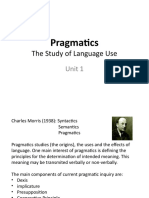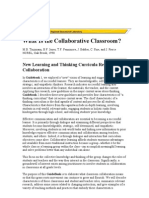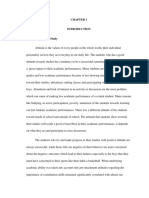Null
Uploaded by
api-27788847Null
Uploaded by
api-27788847http://www.ux1.eiu.edu/~cfbxb/class/1900/prag/intro.
htm
Pragmatics: Basic Concepts
1. Language Use. We begin by setting out a good
working definition of pragmatics.
Pragmatics: the study of language use in
particular situations
This talk about “use” might seem like old hat, after
our study of semantics. After all, the rules
for “using” a sentence like “It's raining” are pretty
simple: you say it when it's raining, and you don't
say it when it's not. In other words, you say the
sentence in those contexts where it's true, and you
don't say it in contexts where it's false. If language
use boils down to a matter of truth and falsehood,
then it looks like “the study of language use in
particular contexts” is just good old semantics. So
who need pragmatics?
But that picture of language use is far too simple. In
fact, we can see, from a couple simple examples,
that even when we've nailed down the semantics of
a sentence (its truth and meaning), we still haven't
settled how the sentence is used in a particular
context.
Consider the following example, where the same
sentence (meaning the same thing throughout)is
used in two different ways (in two different
contexts):
1. My car is in a No Parking zone, and a police
officer approaches. I tell him: “My car has a flat
tire”.
2. I enter a tire store, and tell the person at the
counter: “My car has a flat tire”.
Now, the sentence is equally true in both cases;
and, indeed, the all the words in the sentence (and
so the whole sentence itself) means the same thing
in both cases. So in terms of semantics – meaning
and truth – the sentence is the same in both cases.
Still, I'm using the sentence to do different things in
the two situations – to excuse myself in the first
context, to request help in the second. This feature
of use, above and beyond the semantic issues of
truth and meaning, is the sort of thing pragmatics is
concerned with; and we see that, even when the
semantic dust has settled, there are still pragmatic
issues to be dealt with.
2. Unspoken Messages. A way of understanding
this talk about "using" is to think of it in terms of
communicating unspoken messages: In both
contexts, I'm reporting my flat tire; but in each case
I'm also communicating some second message as
well (“It's not my fault I'm in a No Parking
zone”; “I would like you to fix the tire”.)
In each case my audience immediately understands
the unspoken message I'm communicating. And
notice it's a different unspoken message in the two
cases – so there was nothing about the words in the
sentence that tipped off the listener (they remained
the same throughout). So how do we know which
unspoken message to 'get'? (We don't hear it – it's
unspoken!)
(i) Obviously the context of utterance makes a big
difference as to which unspoken message gets sent
(that's what changed from one case to the next).
(ii) We will propose that we share certain implicit
(unspoken) conversational rules for how to
communicate unspoken messages – if you and I use
the same rules, then you'll be able to figure out
what I'm leaving unsaid.
3. Conversations. To spell this out more carefully,
we introduce some very basic pragmatic notions
that we will build off of. The most basic is the
Conversation.
A conversation is any episode of language use to
communicate information from one person to
some other(s)
Notice that a conversation doesn't have to be an
even exchange: a logic lecture is an extended (and
very one-sided) conversation, because it involves at
least two participants and language is being used to
communicate information. So “conversation,” in
the special sense meant here, includes what we'd
ordinarily call a conversation, but much more as
well – any episode of linguistic communication
involving (at least) two parties. (But talking to
yourself doesn't count as a conversation.)
4. The Conversational Background. As
conversations proceed, and as we move from one
conversation to the next, we accumulate
information – for example, all the sentences we've
heard (and accepted). For instance, there are things
I can count on you to know about the definition of
the word “pragmatics” now; but I couldn't have
expected you to know this information (say) a week
ago. So that definition is now in the background of
accepted information that we hold in common, and
we can all count on each other to know that
information in our conversation.
We call this set of accepted background sentences
the Conversational Background.
We might consider defining the Conversational
Background as the set of sentences believed by all
the participants in a conversation. But in fact that
definition would be too narrow, since we
sometimes we share a common assumption, for the
sake of discussion, that in fact we don't all believe.
For example, an atheist could discuss the nature of
God with someone who believes in God (saying
things like “But then why does God allow evil in
the world?” etc.), and speak throughout the
conversation as if God exists, even though he didn't
believe in God. He would then be 'entertaining' the
claim “God exists,” temporarily adopting this claim
for the sake of argument, without truly believing it.
The same sort of temporary assumption occurs in
discussion of fictional people and events. In a
discussion of Sherlock Holmes' behavior and
attitudes, we assume (for the duration of the
discussion) that Sherlock Holmes exists, and has
the characteristics reported in the stories by A.C.
Doyle, and so on; but we don't necessarily believe
these claims. On the other hand, if we are
disagreeing about whether Jupiter is further from
Earth than Saturn, we are likewise accepting that
Jupiter and Saturn exist – and here we really
believe this. In both cases the claims are in the
conversational background. The claim that
Sherlock Holmes exists and did those things is only
temporarily in the conversational background, for
the duration of our literary discussion; but we don't
go on through life continuing to assume these
things. The claim that Jupiter and Saturn exist is, by
contrast, an enduring part of the conversational
background, that we remain committed to
throughout our day.
(Fans of symbolic logic can think of two other
familiar cases where we temporarily adopt claims
for the sake of argument: the assumptions of
Conditional and Indirect Deductions. In
Conditional Deductions we temporarily assume one
sentence, and show that it leads to another
sentence; but when we're done with the CD, we
don't remain committed to that assumption, only to
the claim that if that assumption [the antecedent]
were true, the second claim [the consequent] would
be as well. Likewise in an Indirect Deduction, we
assume a certain sentence for the sake of argument,
only to show that it would lead to an absurdity or
impossibility – at which point we kick out that
original assumption, and believe its opposite
instead. In both cases the assumption is dropped
once we close the derivation box.)
We will use the general word “acceptance” to cover
both kinds of conversational commitment to a
sentence – the temporary, hypothetical commitment
to the existence of Sherlock Holmes, and the
enduring commitment to the existence of Saturn
and Jupiter. We can then define the Conversational
Background in terms of acceptance:
The conversational background is the set of
sentences accepted by all the participants in a
conversation
We turn next to the various ways of getting
sentences into the Conversational Background.
beakley > 1900 > pragmatics next: presuppositions
You might also like
- Mannoni, Prospero & Caliban (Intro., Ch1)No ratings yetMannoni, Prospero & Caliban (Intro., Ch1)19 pages
- Where The Forest Meets The Sea Sample Lesson Plan100% (2)Where The Forest Meets The Sea Sample Lesson Plan29 pages
- Ahmad Sarifudin (1114025022) Summary Chapter I Definition and BackgroundNo ratings yetAhmad Sarifudin (1114025022) Summary Chapter I Definition and Background30 pages
- Topic: Pragmatics: Presented by Mehwish Nazar Roll No.12No ratings yetTopic: Pragmatics: Presented by Mehwish Nazar Roll No.1235 pages
- Lecture 1 - An Introduction To SemanticsNo ratings yetLecture 1 - An Introduction To Semantics43 pages
- Pragmatics: Aspects of Meaning: Prepared By: Cleo S. Madia Master of Arts in EnglishNo ratings yetPragmatics: Aspects of Meaning: Prepared By: Cleo S. Madia Master of Arts in English44 pages
- Chapter 2 - Discourse Analysis - Gillian Brown and YuleNo ratings yetChapter 2 - Discourse Analysis - Gillian Brown and Yule6 pages
- Lingıistic I Semantics Pragmatics Weeks 12-13 14No ratings yetLingıistic I Semantics Pragmatics Weeks 12-13 1423 pages
- Appunti Lingua Inglese 3 Zurru 2018 2018 Levonyan AnteprimaNo ratings yetAppunti Lingua Inglese 3 Zurru 2018 2018 Levonyan Anteprima8 pages
- A WRITTEN REPORT ON PRAGMATICS AND THE ENGLISH LANGUAGE (Monograph in English 508)No ratings yetA WRITTEN REPORT ON PRAGMATICS AND THE ENGLISH LANGUAGE (Monograph in English 508)15 pages
- Areas of Enquiry - Semantics and PragmaticsNo ratings yetAreas of Enquiry - Semantics and Pragmatics10 pages
- Areas of Enquiry - Semantics and Pragmatics - Acosta, Moreno and Urbieta CORRECTIONSNo ratings yetAreas of Enquiry - Semantics and Pragmatics - Acosta, Moreno and Urbieta CORRECTIONS13 pages
- Vandijk 1998 Critical Discourse AnalysisNo ratings yetVandijk 1998 Critical Discourse Analysis49 pages
- Embedding ICT in The Literacy and Numeracy Strategies: Final Report April 2005No ratings yetEmbedding ICT in The Literacy and Numeracy Strategies: Final Report April 200573 pages
- Teaching Media Literacy in The Age of The Internet: CoverNo ratings yetTeaching Media Literacy in The Age of The Internet: Cover3 pages
- Computers and Opportunities For Literacy Development. ERIC/CUE Digest No. 54No ratings yetComputers and Opportunities For Literacy Development. ERIC/CUE Digest No. 546 pages
- Writing To Learn: Designing Interactive Learning Environments To Promote Engagement in Learning Through WritingNo ratings yetWriting To Learn: Designing Interactive Learning Environments To Promote Engagement in Learning Through Writing17 pages
- Ways Forward With ICT: Effective Pedagogy Using Information and Communications Technology in Literacy and Numeracy in Primary SchoolsNo ratings yetWays Forward With ICT: Effective Pedagogy Using Information and Communications Technology in Literacy and Numeracy in Primary Schools7 pages
- Developing Story-Writing Skills With Year 2 Pupils Using ICTNo ratings yetDeveloping Story-Writing Skills With Year 2 Pupils Using ICT5 pages
- English Teachers' Barriers To The Use of Computer-Assisted Language LearningNo ratings yetEnglish Teachers' Barriers To The Use of Computer-Assisted Language Learning8 pages
- Engaging Students Through ICT: A Multiliteracies ApproachNo ratings yetEngaging Students Through ICT: A Multiliteracies Approach4 pages
- Learner-Friendly Technology in A Brain-Friendly Classroom: Appropriate Technology in The Service of ProficiencyNo ratings yetLearner-Friendly Technology in A Brain-Friendly Classroom: Appropriate Technology in The Service of Proficiency7 pages
- Teaching The Correct Use of Omissive Apostrophes in Year 4 Using Multimedia SoftwareNo ratings yetTeaching The Correct Use of Omissive Apostrophes in Year 4 Using Multimedia Software5 pages
- Asynchronous Online Conference, June 15-30, 1998No ratings yetAsynchronous Online Conference, June 15-30, 19989 pages
- Presenting Texts and Supporting Writing With ICT in Year 2: The School The PupilsNo ratings yetPresenting Texts and Supporting Writing With ICT in Year 2: The School The Pupils4 pages
- E-Learning and The Development of Intercultural Competence: Meei-Ling Liaw National Taichung UniversityNo ratings yetE-Learning and The Development of Intercultural Competence: Meei-Ling Liaw National Taichung University16 pages
- The Internet For English Teaching: Guidelines For TeachersNo ratings yetThe Internet For English Teaching: Guidelines For Teachers6 pages
- Developing Intercultural Awareness and Writing Skills Through Email ExchangeNo ratings yetDeveloping Intercultural Awareness and Writing Skills Through Email Exchange9 pages
- How Well Are ESL Teachers Being Prepared To Integrate Technology in Their Classrooms?No ratings yetHow Well Are ESL Teachers Being Prepared To Integrate Technology in Their Classrooms?32 pages
- Knowledge and Innovation: Building Bridges of CommunicationNo ratings yetKnowledge and Innovation: Building Bridges of Communication5 pages
- A Principled Consideration of Computers & Reading in A Second LanguageNo ratings yetA Principled Consideration of Computers & Reading in A Second Language26 pages
- Assessing Language Development in Bilingual Preschool Children Part II: Language Development in Bilingual ChildrenNo ratings yetAssessing Language Development in Bilingual Preschool Children Part II: Language Development in Bilingual Children5 pages
- Multilingualism: Guadalupe Valdés Multilingualism in The WorldNo ratings yetMultilingualism: Guadalupe Valdés Multilingualism in The World2 pages
- The Internet As A Teaching and Learning Tool in The ESL ClassroomNo ratings yetThe Internet As A Teaching and Learning Tool in The ESL Classroom12 pages
- What Is The Collaborative Classroom?: New Learning and Thinking Curricula Require CollaborationNo ratings yetWhat Is The Collaborative Classroom?: New Learning and Thinking Curricula Require Collaboration27 pages
- Effective Language Education Practices: Cooperative Approaches To Language LearningNo ratings yetEffective Language Education Practices: Cooperative Approaches To Language Learning7 pages
- Local and Global Language Multicultural Settings100% (2)Local and Global Language Multicultural Settings6 pages
- 2017 Chu ITTFProceedings AcceptedPaperVersionNo ratings yet2017 Chu ITTFProceedings AcceptedPaperVersion9 pages
- Lesson Plan Objectives: Plants and AnimalsNo ratings yetLesson Plan Objectives: Plants and Animals7 pages
- Attitude of The Students Towards Academic Performance2.100% (3)Attitude of The Students Towards Academic Performance2.22 pages
- QwikResume - Your Guide To Perfect Resume Assistant Site ManagerNo ratings yetQwikResume - Your Guide To Perfect Resume Assistant Site Manager3 pages
- 14 Principles of Management (Henry Fayol)No ratings yet14 Principles of Management (Henry Fayol)2 pages
- Ahmad Sarifudin (1114025022) Summary Chapter I Definition and BackgroundAhmad Sarifudin (1114025022) Summary Chapter I Definition and Background
- Topic: Pragmatics: Presented by Mehwish Nazar Roll No.12Topic: Pragmatics: Presented by Mehwish Nazar Roll No.12
- Pragmatics: Aspects of Meaning: Prepared By: Cleo S. Madia Master of Arts in EnglishPragmatics: Aspects of Meaning: Prepared By: Cleo S. Madia Master of Arts in English
- Chapter 2 - Discourse Analysis - Gillian Brown and YuleChapter 2 - Discourse Analysis - Gillian Brown and Yule
- Appunti Lingua Inglese 3 Zurru 2018 2018 Levonyan AnteprimaAppunti Lingua Inglese 3 Zurru 2018 2018 Levonyan Anteprima
- A WRITTEN REPORT ON PRAGMATICS AND THE ENGLISH LANGUAGE (Monograph in English 508)A WRITTEN REPORT ON PRAGMATICS AND THE ENGLISH LANGUAGE (Monograph in English 508)
- Areas of Enquiry - Semantics and Pragmatics - Acosta, Moreno and Urbieta CORRECTIONSAreas of Enquiry - Semantics and Pragmatics - Acosta, Moreno and Urbieta CORRECTIONS
- Embedding ICT in The Literacy and Numeracy Strategies: Final Report April 2005Embedding ICT in The Literacy and Numeracy Strategies: Final Report April 2005
- Teaching Media Literacy in The Age of The Internet: CoverTeaching Media Literacy in The Age of The Internet: Cover
- Computers and Opportunities For Literacy Development. ERIC/CUE Digest No. 54Computers and Opportunities For Literacy Development. ERIC/CUE Digest No. 54
- Writing To Learn: Designing Interactive Learning Environments To Promote Engagement in Learning Through WritingWriting To Learn: Designing Interactive Learning Environments To Promote Engagement in Learning Through Writing
- Ways Forward With ICT: Effective Pedagogy Using Information and Communications Technology in Literacy and Numeracy in Primary SchoolsWays Forward With ICT: Effective Pedagogy Using Information and Communications Technology in Literacy and Numeracy in Primary Schools
- Developing Story-Writing Skills With Year 2 Pupils Using ICTDeveloping Story-Writing Skills With Year 2 Pupils Using ICT
- English Teachers' Barriers To The Use of Computer-Assisted Language LearningEnglish Teachers' Barriers To The Use of Computer-Assisted Language Learning
- Engaging Students Through ICT: A Multiliteracies ApproachEngaging Students Through ICT: A Multiliteracies Approach
- Learner-Friendly Technology in A Brain-Friendly Classroom: Appropriate Technology in The Service of ProficiencyLearner-Friendly Technology in A Brain-Friendly Classroom: Appropriate Technology in The Service of Proficiency
- Teaching The Correct Use of Omissive Apostrophes in Year 4 Using Multimedia SoftwareTeaching The Correct Use of Omissive Apostrophes in Year 4 Using Multimedia Software
- Presenting Texts and Supporting Writing With ICT in Year 2: The School The PupilsPresenting Texts and Supporting Writing With ICT in Year 2: The School The Pupils
- E-Learning and The Development of Intercultural Competence: Meei-Ling Liaw National Taichung UniversityE-Learning and The Development of Intercultural Competence: Meei-Ling Liaw National Taichung University
- The Internet For English Teaching: Guidelines For TeachersThe Internet For English Teaching: Guidelines For Teachers
- Developing Intercultural Awareness and Writing Skills Through Email ExchangeDeveloping Intercultural Awareness and Writing Skills Through Email Exchange
- How Well Are ESL Teachers Being Prepared To Integrate Technology in Their Classrooms?How Well Are ESL Teachers Being Prepared To Integrate Technology in Their Classrooms?
- Knowledge and Innovation: Building Bridges of CommunicationKnowledge and Innovation: Building Bridges of Communication
- A Principled Consideration of Computers & Reading in A Second LanguageA Principled Consideration of Computers & Reading in A Second Language
- Assessing Language Development in Bilingual Preschool Children Part II: Language Development in Bilingual ChildrenAssessing Language Development in Bilingual Preschool Children Part II: Language Development in Bilingual Children
- Multilingualism: Guadalupe Valdés Multilingualism in The WorldMultilingualism: Guadalupe Valdés Multilingualism in The World
- The Internet As A Teaching and Learning Tool in The ESL ClassroomThe Internet As A Teaching and Learning Tool in The ESL Classroom
- What Is The Collaborative Classroom?: New Learning and Thinking Curricula Require CollaborationWhat Is The Collaborative Classroom?: New Learning and Thinking Curricula Require Collaboration
- Effective Language Education Practices: Cooperative Approaches To Language LearningEffective Language Education Practices: Cooperative Approaches To Language Learning
- Attitude of The Students Towards Academic Performance2.Attitude of The Students Towards Academic Performance2.
- QwikResume - Your Guide To Perfect Resume Assistant Site ManagerQwikResume - Your Guide To Perfect Resume Assistant Site Manager




















































































































